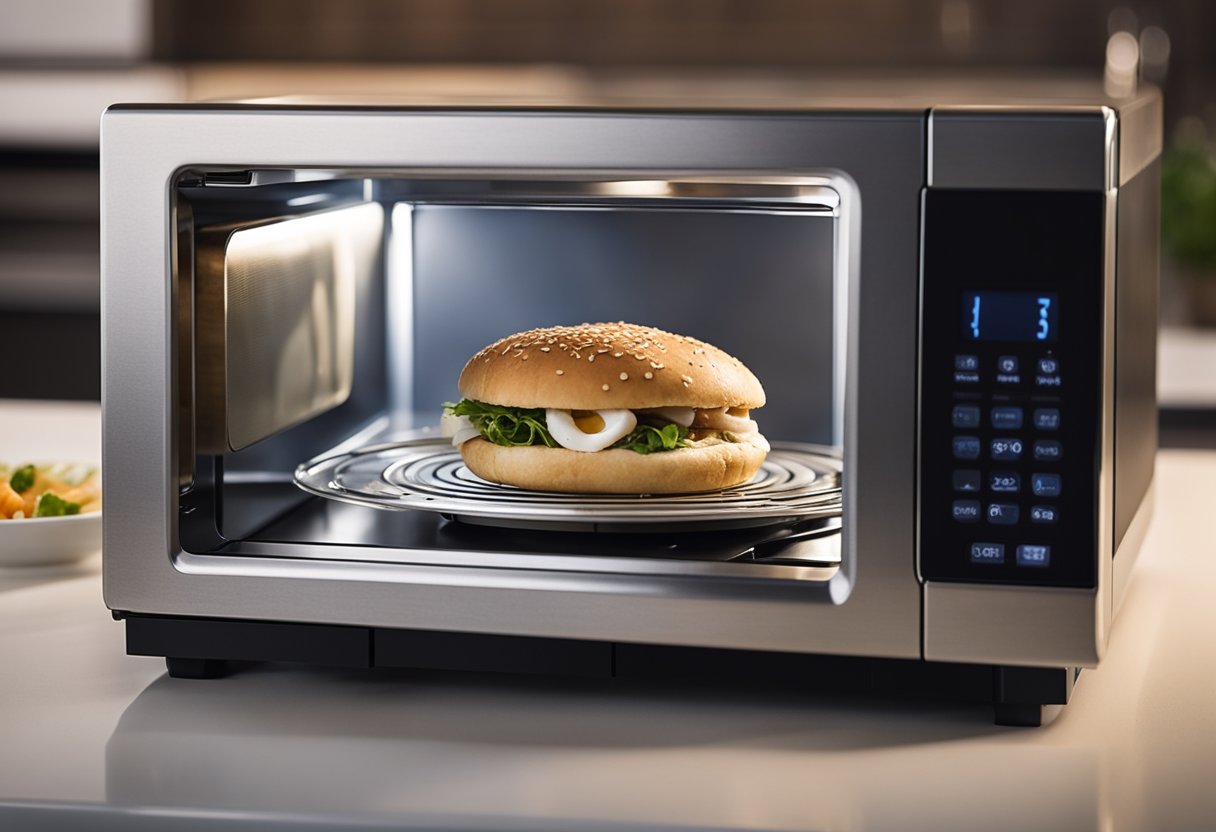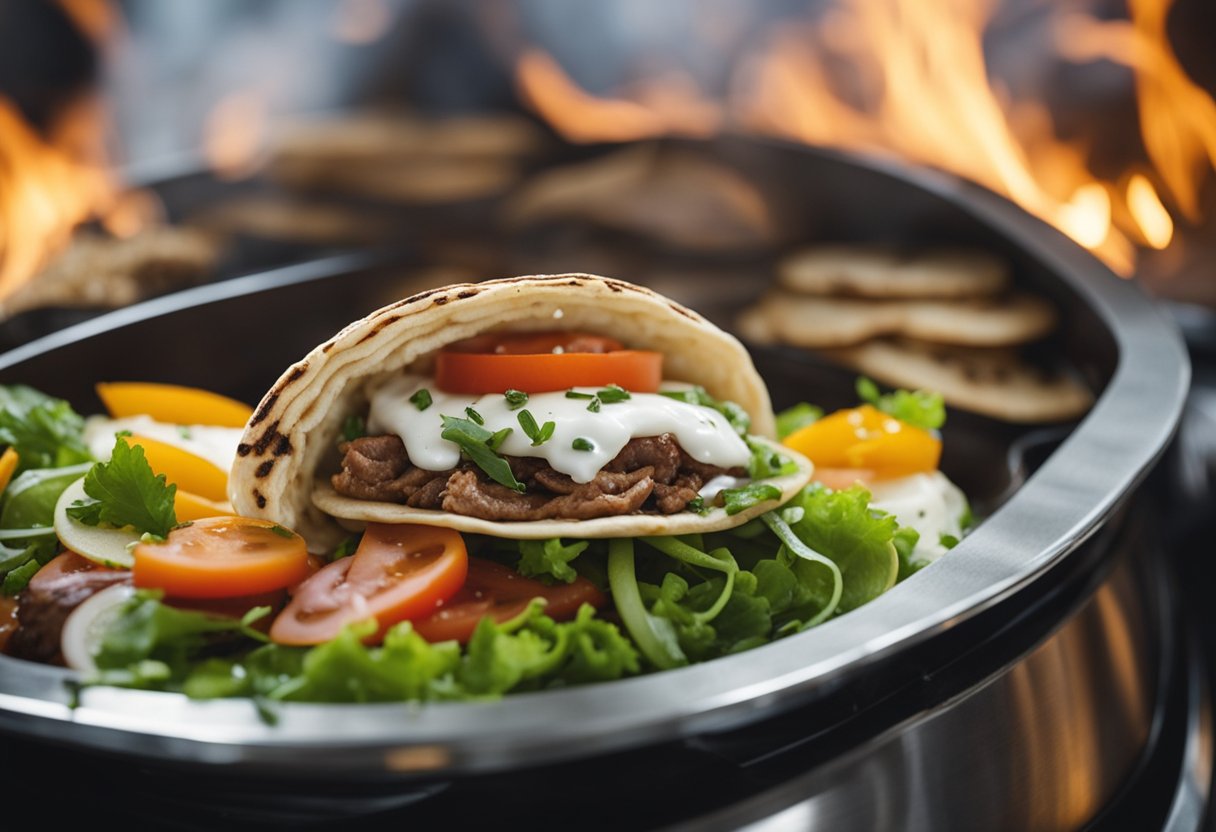As a gyro lover, I know that reheating leftover gyro can be a tricky task. Gyro meat can easily dry out or become chewy if not reheated properly.
However, fear not, as I have found some foolproof ways to reheat gyro that will leave it tasting just as delicious as it did when it was first served.

Preparing your gyro for reheating is the first step to ensuring that it comes out just as tasty as it did before.
It’s important to remove any toppings or sauces before reheating, as they can become soggy or lose their flavor. Next, you’ll want to separate the meat from any pita bread or other sides that may have been served with the gyro.
Reheating gyro in the oven is one of the most effective ways to restore its crispiness and retain its original flavors. Simply preheat your oven to 350°F (175°C), place the meat on a baking sheet, and bake for 5-10 minutes or until heated through.
Alternatively, you can reheat gyro on the stove or in the microwave, but these methods may not yield the same crispy texture as oven reheating.
Key Takeaways
- Remove any toppings or sauces before reheating gyro to prevent sogginess.
- Separating the meat from any pita bread or sides is important for even reheating.
- Oven reheating is the most effective way to restore gyro’s crispiness and original flavors.
Preparing Your Gyro for Reheating
As much as we love a freshly made gyro, sometimes we just can’t finish the whole thing. Whether you ordered too much or made too many at home, reheating leftover gyro is a great way to enjoy it again.
However, to ensure the best taste and texture, it’s important to prepare your gyro properly before reheating.
Handling Leftovers
First and foremost, it’s essential to handle your leftover gyro correctly. After you’re done eating, make sure to store any uneaten gyro in an airtight container. This will help prevent the growth of harmful bacteria and keep your gyro fresh for longer.
If you’re planning on reheating your gyro within a day or two, store it in the refrigerator. However, if you don’t plan on reheating it for a few days, you can freeze it instead. Just make sure to wrap it tightly in plastic wrap or foil before placing it in the freezer.
Bringing Gyro to Room Temperature
Before reheating your gyro, it’s essential to bring it to room temperature. This will help ensure that it heats evenly and doesn’t dry out.
To do this, simply take your gyro out of the refrigerator or freezer and let it sit at room temperature for about 30 minutes.
If you’re in a rush and don’t have time to wait, you can also place your gyro in the microwave for a few seconds to help bring it to room temperature. Just be careful not to overheat it, as this can cause the meat to dry out.
Overall, preparing your gyro for reheating is a crucial step in ensuring that it tastes just as good as the first time around. By handling your leftovers correctly and bringing your gyro to room temperature, you can enjoy a delicious and satisfying meal all over again.
Reheating Gyro in the Oven
When it comes to reheating gyro, the oven is a great option. It’s easy to use and allows for even heating throughout the meat.
Here are some tips for reheating gyro in the oven:
Using a Baking Sheet
To reheat gyro in the oven, start by preheating the oven to 350°F (175°C). While the oven is preheating, take out a baking sheet and line it with foil. This will help prevent the gyro from sticking to the baking sheet and make cleanup easier.
Once the oven is preheated, place the leftover gyro meat on the foil-lined baking sheet. Be sure to separate the components of the gyro, such as the meat, pita bread, and veggies, into separate containers or plates for even reheating.
Maintaining Moisture
To maintain the moisture of the gyro while reheating in the oven, add a splash of water or broth to the meat before placing it in the oven. This will help keep the meat from drying out and becoming tough.
Cover the baking sheet with foil and place it in the preheated oven. Cook the gyro for about 10 minutes, or until it’s heated through. If you’re looking for extra crispiness, remove the foil during the last few minutes of cooking.
Temperature and Cooking Time
It’s important to reheat gyro at the right temperature and for the right amount of time to ensure that it’s heated through without becoming overcooked. A temperature of 350°F (175°C) and a cooking time of about 10 minutes should be sufficient.
In conclusion, reheating gyro in the oven is a great option for those looking for even heating and a crispy texture. By using a baking sheet and maintaining moisture, you can ensure that your gyro is heated through and delicious.
Reheating Gyro on the Stove
When it comes to reheating gyro meat, the stove is a great option, and it can help you achieve that crispy texture that everyone loves. In this section, I will share some tips on how to reheat gyro meat on the stove.
Utilizing a Skillet
One of the best ways to reheat gyro meat on the stove is by using a skillet. To start, heat up a non-stick skillet over medium-low heat. Once the skillet is hot, place the leftover gyro meat in the skillet directly without any added oil or butter.
It is important to note that gyro meat is usually already cooked, so you don’t want to overcook it. Overcooking the meat can make it tough and dry, which is not what you want. Instead, you want to cook the gyro meat until it is heated through and tender.
Avoiding Overcooking
To avoid overcooking the gyro meat, you can cover the skillet with a lid or foil. This will trap the heat inside the skillet and help the meat heat up faster. You can also add a tablespoon of olive oil to the skillet to help keep the meat moist and tender.
If you want to achieve that crispy texture, you can remove the lid or foil during the last few minutes of cooking. This will allow the gyro meat to crisp up a bit. Just be sure to keep an eye on the meat to avoid overcooking it.
In conclusion, reheating gyro meat in a skillet on the stove is a great way to achieve that crispy texture everyone loves. Just be sure to cook the meat until it is heated through and tender, and avoid overcooking it. By following these tips, you can enjoy delicious reheated gyro meat anytime.
Reheating Gyro in the Microwave
When it comes to reheating gyro, the microwave can be a quick and convenient option. However, it’s important to know the right techniques to prevent sogginess and ensure your gyro comes out moist and delicious.
In this section, I will share some microwave-safe techniques and tips to prevent sogginess.
Microwave-Safe Techniques
To reheat gyro in the microwave, you’ll need a microwave-safe plate and a damp paper towel. Here are the steps to follow:
- Place the gyro on a microwave-safe plate.
- Dampen a paper towel with water and wring out the excess moisture.
- Cover the gyro with the damp paper towel.
- Microwave the gyro on high for 30 seconds.
- Check the gyro for hotness. If it’s not hot enough, microwave it for another 15-30 seconds.
Preventing Sogginess
One of the biggest challenges when reheating gyro in the microwave is preventing sogginess. Here are some tips to help you avoid this problem:
- Remove any cold toppings, such as lettuce or tomatoes, before reheating the gyro. This will help prevent sogginess and maintain their freshness.
- Use a microwave-safe plate to ensure even reheating and prevent any damage to the gyro pita.
- Use a damp paper towel to add moisture and prevent the gyro from drying out. However, be sure to wring out the excess moisture to prevent sogginess.
- If the gyro does become soggy, try placing it in the oven or a toaster oven for a few minutes to crisp it up.
By following these microwave-safe techniques and tips, you can reheat gyro in the microwave without worrying about sogginess.
Reheating Gyro Using Alternative Methods
When it comes to reheating gyro, there are several alternative methods you can try, especially if you don’t have access to an oven or stovetop. In this section, I’ll explore two popular methods: the air fryer and the toaster oven.
Trying the Air Fryer
An air fryer is a great option if you want to reheat your gyro with a crispy texture. Start by preheating your air fryer to 400°F (200°C).
Then, place your gyro slices in the air fryer basket, making sure they don’t overlap. If you’re reheating a gyro sandwich, wrap it in foil or parchment paper before placing it in the air fryer basket.
Cook the gyro slices for about 5-7 minutes, or until they’re heated through and crispy. Keep an eye on them to make sure they don’t burn. Once they’re done, remove them from the air fryer and serve immediately.
Exploring the Toaster Oven
If you don’t have an air fryer, you can also use a toaster oven to reheat your gyro. Preheat your toaster oven to 350°F (175°C).
Then, place your gyro slices on a baking sheet lined with foil or parchment paper. If you’re reheating a gyro sandwich, wrap it in foil or parchment paper before placing it on the baking sheet.
Bake the gyro slices for about 10-12 minutes, or until they’re heated through. If you want them to be extra crispy, you can broil them for an additional 2-3 minutes. Once they’re done, remove them from the toaster oven and serve immediately.
Both the air fryer and toaster oven are great alternatives to the oven or stovetop when it comes to reheating gyro.
They both produce crispy, delicious results, and are easy to use. Just make sure to keep an eye on your gyro slices to prevent burning, and wrap your gyro sandwich in foil or parchment paper to keep it from getting soggy.
Frequently Asked Questions

What is the best method to reheat gyro meat?
The best method to reheat gyro meat is by using an oven. Preheat your oven to 350°F (175°C). Wrap the gyro meat gently in aluminum foil and place it on an oven-safe tray or baking sheet. Bake for approximately 10 minutes until heated through.
This method ensures that your gyro retains its original texture and flavor without becoming too dry or soggy. You can also reheat gyro meat in an air fryer, which is a quick and convenient method.
However, it is important to note that the air fryer method may result in a slightly different texture compared to the oven method.
Can pita bread be reheated without losing its texture?
Yes, pita bread can be reheated without losing its texture. The best way to reheat pita bread is by using an oven or toaster oven.
Preheat your oven to 350°F (175°C) and place the pita bread on a baking sheet. Bake for approximately 5 minutes until heated through. This method will help the pita bread regain its chewy texture.
Is it safe to consume gyro meat that has been refrigerated for several days?
Gyro meat can be refrigerated for up to three to four days. It is safe to consume gyro meat that has been refrigerated for several days as long as it has been stored properly.
Make sure to store the gyro meat in an airtight container and place it in the fridge as soon as possible after cooking.
What are the guidelines for reheating Tzatziki sauce?
Tzatziki sauce should not be reheated as it contains yogurt, which can curdle when heated. It is best to serve Tzatziki sauce cold. If you must reheat it, do so gently over low heat in a saucepan, stirring constantly until it is heated through.
How can you use an air fryer to reheat gyro slices effectively?
To use an air fryer to reheat gyro slices effectively, preheat your air fryer to 350°F (175°C). Place the gyro slices in the air fryer basket and cook for 3-5 minutes until heated through. This method will help the gyro slices regain their crispiness.
Is it possible to reheat a gyro and still maintain its original flavor?
Yes, it is possible to reheat a gyro and still maintain its original flavor. The best method to reheat a gyro is by using an oven.
This method helps the gyro retain its original texture and flavor without becoming too dry or soggy. It is important to note that reheating gyro in an air fryer may result in a slightly different texture compared to the oven method.







